|
|
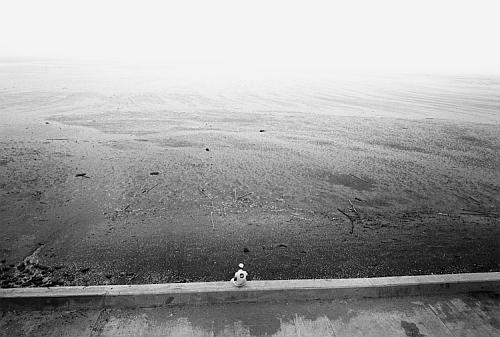
Funabashi City: Health Center
July 17, 1968
Towards the city
Yutaka Takanashi
Galerie Priska Pasquer
_______________________
The shadow cast by writing
Stephen Mitchelmore
This Space
(....)This summer, the one and a half pages of notes became a fetish for me, offering the possibility of a more elemental form of writing, one which dissolves well-attuned habit and reveals an alternative life; not, that is, a different life but the one waiting to be discovered. Why else would a few hundred words scratched out in a brief, forgotten time stir me while all the intricate ideas, elaborate plans and laborious executions leave me blank and disconnected? On what does the appearance of its alternative depend? Chance alone it would seem.
While it would not be presumptuous to dismiss such writing as occasional autobiographical digressions carrying its charge in the singular impact it has on the writer, this would obscure what needs to be isolated as unique to writing. But how can it be maintained or codified into a public form?
I was reminded of these questions as Geoff Dyer and Lee Siegel added to the surge of voices condemning the worldly disappointments of contemporary fiction and instead advocating creative non-fiction. Both arguments rest on the notion of the novel as a means of narrating events in the empirical world and of engaging readers with company, information and meaning. The novel may be the apotheosis of "characterisation, observation and narrative drive" but now it has a more worldly equal. Given the examples offered, it's no wonder the war reportage Dyer celebrates appears more vital, exciting and relevant, while Siegel's call (couched in tabloid sneer) for literary fiction to be more commercial and realistic in order "illumine the ordinary events of ordinary lives" also seems fair if we assume that war and peace are the poles between which real life spins; a roadside bomb and a divorce spraying shrapnel into flesh and spirit. So how can the writing that stirs me – haphazard, unworldly – respond to these rousing condemnations?...(more)
_______________________

Photography is Easy - Version 2 (2010)
Leslie Thornton
In the ongoing project Photography is Easy, Thornton continues her investigation of the production of meaning through media such as photography, film and video. Thornton and a companion are seen hiking through a desert, photographing and recording the journey. Shots of desert landscapes are overlaid with the artist's running commentary and text about Thornton's experience of making a photograph. Questioning the value of the rarified image, Thornton investigates the porous boundaries between the still and the moving image.
Nine Films Leslie Thornton UbuWeb Film & Video Refracted through archival material, texts, found footage and dense soundtracks, Leslie Thornton's rigorously experimental film and video work is an investigation into the production of meaning through media. For Thornton, form and content are co-extensive, as exemplified by her epic project Peggy and Fred in Hell, an ongoing cycle of interrelated films, videos and installation environments focusing on two children who have been "raised by television." Heterogeneous and open-ended, the series defies conceptions of masterwork, author, and the strictures of beginning, middle and end.
This resistance to categorization is informed by Thornton's concerns with language and her view of media as a linguistic system that is ideologically coded and subject to the controls of culture and the market. Her works are interventions on contested terrain, in which the stakes are conventions of reading and writing, legibility and transparency. For Thornton, the conventions of narrative and montage must not simply be renounced, but used as tools against themselves. The result is a unique and strangely beautiful syntax, one that poses its critique at the same time that it mesmerizes, confounds and provokes. Thornton writes, "I see myself as writing with media, and I position the viewer as an active reader, not a consumer. The goal is not a product, but shared thought." ...(more
via gmtPlus9 (-15))
_______________________
Three Poems
Eric Higgins
conjunctions
For Now
The history you will write of yourself will be a re-telling.
You will narrate your image into power. A position of.
On a mattress you even almost to yourself will appear to sleep royally.
These instructions are swiftly written. Around them vapors flit.
I shiver, continue:
guards at the door bound to protect but
heat and sweat they loosen. The march is nearing, torches
raised on power progress. It will come from one of your own.
On the guards the flickerflame paints a menace but it is cowardice,
fathomless, that braces the abused. The guards dispatched.
Blood pistoning. Eyes red as whitewater.
He will slide his knife through you and grow immediately timid.
In your bedclothes you will fall.
Do not become despised, hated, or stricken—and
Prince: hold your deep dark rose in your chest closed.
...(more)
_______________________
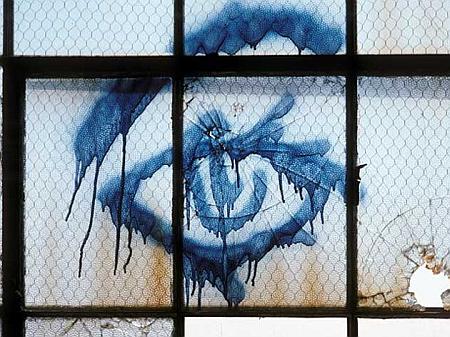
Invincible Cities
Camilo José Vergara via Junk for Code
1 2
_______________________
New Media Critical Homologies
Brian Lennon
pmc
The computer is one of those swerves in the history of built things that bring whole ways of life to an end -- and seldom with the drama with which the first to sense a change often pronounce it. Real change is painfully slow, building to crisis well off the range of dailiness-numbed sense: a pattern of sun and shadow filtering into a room, here illuminating a particular object for no particular reason, there, with precisely the same absence of portent, shrouding another. There are regressions, and some habits and routines left precisely as they were or are, while others vanish or metastasize. Newness covers the old with a creeping patina, in which what will be and what no longer is exchange places and seem to intermingle, at the same time.
New media studies, we might say, has discovered temporality. After fifteen years in which its cultural dominant was presentist prognostication, even --often enough --a kind of bullying, the field has folded on itself with such new guiding concepts as the "residuality," the "deep time" or "prehistory," and the "forensic imagination" of a new media now understood as after all always already new. This is a more absorbent fold, perhaps, than that embedded in one of the field's originary figures, "remediation" --a determinedly modern progressive figure, though one whose conceptual plasticity always suggested the possibility, beyond linear reframings, of non-modern medial cycles or folds (see Bolter and Grusin). Without a doubt, it is that depth that sends us searching, now, for a reading of the temporal turn that seems all at once to discard and even undermine the prime rhetoric of a field of study settled in self-establishment. Read symptomatically, there is perhaps more to all of this than the usual need for professional distinction in the field itself, which like any mode of absorption of surplus, needs a manufactured boom and bust, on a regular cycle. To the shaming of the slow, the skeptical, and the self-respecting who refuse the unfunded mandates of technocratic reactivity, in the New Economic home-classroom-office pod of unrelievedly public life online, new media studies now adds to its figural repertoire a synchronic complement, in the reflection of what the Jameson of the 1970s, writing Marxism and Form, calls the "commodity structure of academic intellectual life"
Were it not for the institutional dynamic of critical desire through which one is forced to embrace what one declines, in order to scale the heights from which to renounce it again, one might have begun there. But what is done is done. With the swap-file virtualities of an endless present suffering stain, again, we might suspect this anachronic return to time, in a new media studies that seems never to have known it at all, of being sensitive, registrative, or even merely, vulgarly reflective of the sociotemporal order-as-disorder of U.S. imperial and global capitalist crisis, as an apparent crisis of progress. To materialist critiques of the disembodiment of information, which corrected the intellective disposition of an early euphoria without doing much to blunt its complacent productivity, one can certainly imagine being attached, now, a materialist critique of the conditions of the critique of disembodiment, itself, in a resource- intensive field of inquiry into disproportionately resource- intensive social behaviors whose future is inseparable from the future of U.S. consumerism-above all, the consumption of energy. Our appetite for the materiality, as much as for the virtuality of new media, is also a form of systems maintenance. One might say that the specter haunting new media studies today is the late imperial "peak energy" spectacle of middle-class U.S. Americans in sweaters, riding their bicycles to work....(more)
_______________________

Sweet Kingdom Annex
Chene and Superior Streets
Detroit, 1993
Camilo José Vergara
_______________________
Spaces of Identity: Global Media, Electronic Landscapes, and Cultural Boundaries
David Morley and Kevin Robins
ifile pdf via aaaaarg
The book has a double focus throughout. At a theoretical level the prime concern is with the question of identity under the conditions of a postmodern geography—specifically with the complex and contradictory nature of cultural identities and with the role of communications technologies in the reconfiguration of contemporary cultural (and often diasporic) identities. These issues are addressed in the context of the contemporary politics of the relations between Europe and its most significant Others—America, Islam and the Orient—against whom Europe’s own identity has been and is now being defined. The key questions have become those of power, boundarymarking and exclusion processes, both nationally and internationally. If identity is crucially about difference, the politics of identity necessarily raises questions of authenticity, of roots, tradition and heritage which, in turn, lead into questions of race and ethnicity.
_______________________
WikiLeaks or WikiLedes?
Tom Matrullo
Well, as a reporter, you're very rarely confronted with this amount of information, and so it's almost - it's the reverse of the situation you're normally in, which is too little information. Here, we are confronted with such a volume of information that it's hard to make sense of it and it's hard to know how to - which parts to emphasize and which parts not to.
- Mark Mazzetti
(....)
What Mr. Mazzetti points to as exceptional is in fact the normal case: the actual data out there for any story are potentially infinite. Newsmen deal with digested digests, rarely with the raw. But they forget they are dealing with pre-digested regurgiatives, and think they possess mastery over a certain genuine terrain. They do not.
Wikileaks exposes the abbreviative power of news media. Faced with something like the complexity of the real, Mr. Mazzetti thought he was dealing with something unusual. He was not. The gap between the NYT accounts of Afghanistan before WikiLeaks, and the density of the documents now available is vast. What Mr. Mazzetti and the NYT are looking at is the abyss that is always there in any bit of actuality, but which their customary defenses have always dealt with deftly and obliviously. They'll need a new set of defenses if the leaks keep coming.
(....)
Wikileaks is lifting two veils: one on the war, the other -- perhaps more significant -- on the unreality of everyday journalism, the fictional, smooth, clear narrative arcs of the Times, NPR, MSNBC, etc.
After cataract surgery, the eyes can be sensitive to light....(more)
_______________________
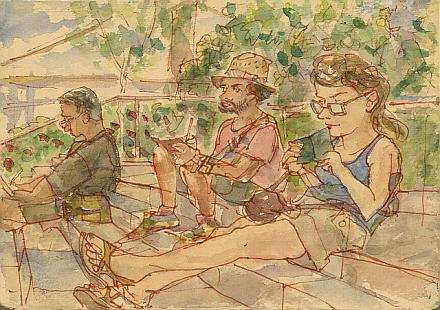
Jason Das
Urban Sketchers
via Sheila Lennon
_______________________
A Personal Note on Japanese Poetry, for Hiromi Ito
Jerome Rothenberg

Lotte
Max Burchartz
1928
.....................................................
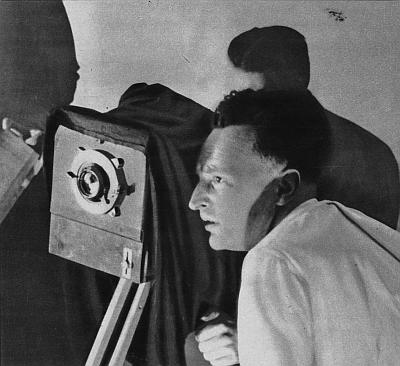
Max Burchartz
b. July 28, 1887 1 2
_______________________
Gaps and their Consequences
Rachel Levitsky
Our expressions, the laconic one and the one responsive to things, many things and every thing, did not read as contradictory. The huge spaces or gaps which either contained them or not made it difficult to reach and actually touch or even less, hold onto, and made this world in which we (still) find ourselves nearly impossible to capture-as it is and as it was-in our head, either all at once as unruly multiplicities and their desperately sought-after negations or as a distinct particular, a single absented thing once there and yet not, and not yet.
For a time we continued to flounder in these gaps, trying to get out from under our sea of stuff, reaching for these things neither there nor named. There, in the gaps, we first sensed that something wrong was being done to us. ...(more)
Rachel Levitsky at PennSound
_______________________
Some Simple Reflections on the Body
Paul Valéry
Translated by Ralph Manheim
ifile pdf - via aaaaarg
And as a protest arose within me, the Voice of the Absurd added: "Think carefully:
Where do you expect to find answers to these philosophical questions? Your
images, your abstractions, derive only from the properties and experiences of your
Three Bodies. But the first offers you nothing but moments; the second a few visions;
and the third, at the cost of ruthless dissections and complicated preparations, a
mass of figures more indecipherable than Etruscan texts. Your mind, with its language,
pulverizes, mixes and rearranges all this and from it, by the abuse, if you
will, of its habitual questionnaire, evolves its notorious problems; but it can give
them a shadow of meaning only by tacitly presupposing a certain Nonexistence —
of which my Fourth Body is a kind of incarnation."
_______________________
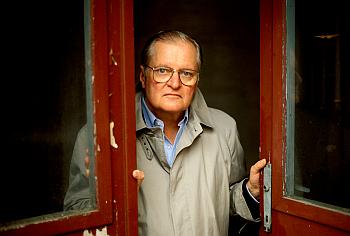
John Ashbery
b. July 28, 1927
photo Giovanni Giovannetti
Boundary Issues
John Ashbery
Here in life, they would understand.
How could it be otherwise? We had groped too,
unwise, till the margin began to give way,
at which point all was sullen, or lost, or both.
Now it was time, and there was nothing for it.
We had a good meal, I and my friend,
slurping from the milk pail, grabbing at newer vegetables.
Yet life was a desert. Come home, in good faith.
You can still decide to. But it wanted warmth.
Otherwise ruse and subtlety would become impossible
in the few years or hours left to us. “Yes, but . . .”
The iconic beggars shuffled off too. I told you,
once a breach emerges it will become a chasm
before anyone’s had a chance to waver. A dispute
on the far side of town erupts into a war
in no time at all, and ends as abruptly. The tendency to heal
sweeps all before it, into the arroyo, the mine shaft,
into whatever pocket you were contemplating. And the truly lost
make up for it. It’s always us that has to pay.
I have a suggestion to make: draw the sting out
as probingly as you please. Plaster the windows over
with wood pulp against the noon gloom proposing its enigmas,
its elixirs. Banish truth-telling.
That’s the whole point, as I understand it.
Each new investigation rebuilds the urgency,
like a sand rampart. And further reflection undermines it,
causing its eventual collapse. We could see all that
from a distance, as on a curving abacus, in urgency mode
from day one, but by then dispatches hardly mattered.
It was camaraderie, or something like it, that did,
poring over us like we were papyri, hoping to find one
correct attitude sketched on the gaslit air, night’s friendly takeover.
_______________________
The Intellectual Construction of "Social Distance":
Toward a Recovery of Georg Simmel’s Social Geometry
Philip J. Ethington
cybergeo
If wandering, considered as a state of detachment from every given point in space, is the conceptual opposite of attachment to any point, then the sociological form of the ‘stranger’ presents the synthesis, as it were, of both these properties. (This is another indication that spatial relations not only are determining conditions of relationships among men, but are also symbolic of those relationships.) Georg Simmel, "The Stranger" (1908)
The relationship between geometric and metaphoric distance should be among the most urgent of research questions in late-twentieth century human sciences. This essay is an attempt to contribute to the ongoing and increasingly rich discourse on space in social theory, by tracing the life course of a critical concept as it has been constructed intellectually and deployed empirically. That social distance needs to be refashioned is a major conclusion of this essay, but precisely how it must be refashioned is a question that I think we are only beginning to see. Not only Georg Simmel among the founders of social theory will be necessary for this reconstruction. Emile Durkheim’s concept of "social morphology," for example, contains important insights into the relationship between geometric and metaphoric meanings of distance (Durkheim 1992). This essay, however, maintains a focus on Simmel, Park, and Bogardus as shapers of the contemporary notion of "social distance."(....)
Simmel had the brilliance to capture in a single social type, “the stranger” the basic elements of social distance. Metaphoric distance is strangeness: the “unfamiliar” (and we must take note of the etymologies here: familiar and unfamiliar are metaphoric of blood kinship). But geometric distance is the structure of everyday life in space-time that permits or promotes the formation of familiarity: ie, the stranger literally was not here when we developed our familiarity. Reciprocally, “structures of feeling” (Williams 1973) produce “structures of practice” (Bourdieu 1980), and vice-versa. A powerful exploitation of recent sociospatial theory needs to accommodate directly both of these senses of distance....(more)
cybergeo european journal of geometry
_______________________
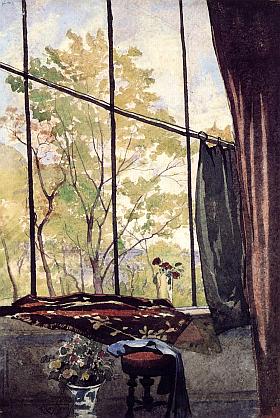
Henri Harpignies
b. June 28, 1819
_______________________
Emergence In History
Manuel DeLanda
Introduction to Philosophy and Simulation: The Emergence of Synthetic Reason
courtesy of Lebbeus Woods
Simulations are partly responsible for the restoration of the legitimacy of the concept of emergence because they can stage interactions between virtual entities from which properties, tendencies, and capacities actually emerge. Since this emergence is reproducible in many computers it can be probed and studied by different scientists as if it were a laboratory phenomenon. In other words, simulations can play the role of laboratory experiments in the study of emergence complementing the role of mathematics in deciphering the structure of possibility spaces. And philosophy can be the mechanism through which these insights can be synthesized into an emergent materialist world view that finally does justice to the creative powers of matter and energy....(more)
_______________________
Concealing screens: Consent, control and the desiring user / Kirsty Best
Abstract: This article traces the contemporary cultural history of consent to information control. It argues that in order to begin to understand why people consent to the loss of control over their digital devices we need to see users as desiring subjects positioned at a cultural moment where the digital information screen has been enlisted as a central driver of both utility and pleasure, but where its architectural ability for additional functional control remains obscured.
Reconstruction Vol. 10, No. 2, 2010
Expertise as Knowledge _______________________
European Journal of Pragmatism and American Philosophy
Volume 2, Number 1, 2010
_______________________
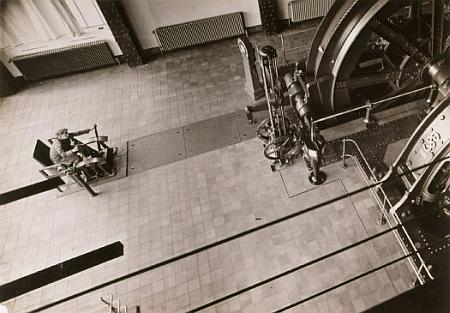
Worker before Machines
Max Burchartz
1928
_______________________
‘THE CHILD is father to the man.’
How can he be? The words are wild.
Suck any sense from that who can:
‘The child is father to the man.’
No; what the poet did write ran,
‘The man is father to the child.’
‘The child is father to the man!’
How can he be? The words are wild.
Gerard Manley Hopkins
July 28, 1844 – June 8, 1889

The Insect Chorus
1917
Charles Burchfield
(1893-1967)
Heat Waves in a Swamp
The Paintings of Charles Burchfield
June 24–October 17, 2010
Whitney Museum of American Art
via
_______________________
Afghanistan: The war logs
The Fog of War, Rediva
John Louis Lucaites
Although it began in the shadow of our occupation in Iraq, our presence in Afghanistan now marks the single longest military expedition in US history—bar none: World War I, World War II, Korea, Vietnam … you name it. Is it a surprise, in this context, that hundreds (if not thousands) of civilians have been killed or wounded under the sign of “collateral damage”? Or that “friendly fire” has taken the lives of both US troops and its allies? Or that there are special black-ops units that operate under “dubious circumstances” with “capture/kill” lists? Or that the microchip technology that was supposed to provide us with a “bloodless victory” has turned out to be less effective than we imagined? Or that drone missions being executed by private contractors sitting safely before computer monitors in remote locations like Nevada are actually putting troops in the field at greater rather than lesser danger when they fail and have to be retrieved before the enemy finds them? Or that the Afghani military is underpaid and unreliable? Or—revelation of revelations—the US military has misled the public regarding the sophistication of the weaponry being employed against us by the Taliban, such as the use of heat seeking missiles to bring down helicopters? Or that Pakistan is not a trustworthy ally? And on and on and on.
The fact of the matter is that we have been shown evidence of virtually every one of these concerns over the past, long, ten years and we have chosen not to see them. Or perhaps the problem is that the reports of such incidents have been fragmented and piecemeal, and thus easily mitigated as “accidents” animated by human or technological error (take your choice), or rationalized as the “necessary and tragic” cost of a war fought to preserve our freedom. Like the soldier in the photograph above, caught in the rotor wash of a MEDEVAC helicopter and thus incapable of seeing the landscape that is directly in front of him, perhaps we have been caught in the swirl of government and mass media reports—too often indistinguishable from one another—to the point of not seeing (or trusting) what is directly before our eyes: a failed war that daily costs us ever more in dollars and human lives with no end or reversal of fortune in sight....(more)
_______________________
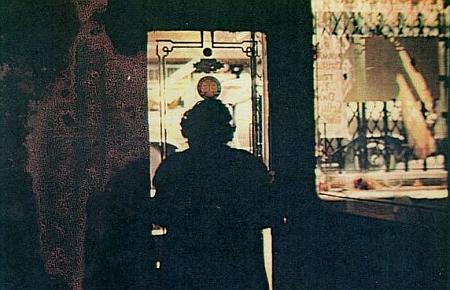
Batya Halpern
1979
Tenement Museum Online Photo Database
via
_______________________
The Derivative World
Caitlin Zaloom
The Hedgehog Review 12.3 (Summer 2010)
Observed through Goffman’s lens, casinos and Wall Street bear dramatic, and dramaturgical, resemblances. First, both are designed to operate as stages. Worlds nestled within worlds, casinos and financial markets heighten the action by regulating space differently from everyday life. Like casinos, Wall Street is a tightly bound site designed to draw in profitable materials from the exterior world while drawing out social distance. Operating remotely from their effects, casinos and financial markets direct their own systems of reward, building action around agonistic contests of calculation. The action also focuses more individual satisfactions, offering access to states of flow, the absorption and exhilaration where all else falls away. In the boom years, finance became its own world, separated from its impact on outsiders, where traders engineered their peak experiences of competition and attention akin to the thrills players seek on Vegas’s casino floors. Let’s call this place Derivative World.
Like casinos, financial markets are explicitly designed to be a world apart. Geographically, though, Wall Street now lacks a single address. Its sites are dispersed across the metropolitan landscape and linked through fiber optic cable, cell signals, cars, and helicopters. Banks and trading floors have mostly moved to midtown Manhattan, clustered together with the high-end law firms that service their needs. Goldman Sachs maintains its downtown location, but now owns a tower in Jersey City. America’s hedge funds cluster in Greenwich. Homes of scale and decadence dot the wealthiest districts of the city, but also New Jersey, Westchester, and Connecticut. Recently, financial firms made massive cutbacks, and investment bankers with big homes and large country club dues suddenly found themselves out of work. But for the survivors, those who disappeared have been quickly forgotten. Two years after financial Armageddon, it’s business as usual once again. Drivers in sleek private cars line the streets outside office buildings and town houses, waiting to shuttle money managers and dealers from site to site among these epicenters of financial profit and payoff. Bankers and traders seek their action within the closed confines of this social world. Consequences—profits and reputations—are rendered within. ...(more)
The Great Mortification: Economists’ Responses to the Crisis of 2007–(and counting)
Philip Mirowski The Hedgehog Review 12.3 (Summer 2010)
The readers may struggle to find it within their own hearts to feel sorry for economists in their plight, and it is not the intention of the current author to stoke pity or even schadenfreude in readers. Rather, the task is to recount these events as a sequence of otherwise avoidable tragedies, the first of which must be conceded to have been the exile of history and philosophy from any place within the contemporary economic orthodoxy.
The Phantom Economyfeature in The Hedgehog Review 12.3 (Summer 2010) Institute for Advanced Studies in Culture
_______________________

Road Trip, Eureka
George LeChat
2010
hiding in plain sight
_______________________
The Briefcase of Walter Benjamin/Benjamin Walter's Briefcase: An Invent/Story
Julian Yates
rhizomes
[5] Understandably, the news that there had been and perhaps that there remains, still, a manuscript, that this briefcase had been, all along, as it turns out, a thoroughly competent briefcase, a briefcase that could still, perhaps, under the right circumstances, and with a little luck or a lot of archival digging, be opened, and the manuscript retrieved, has caused much excitement. Benjamin's editors have inquired into its whereabouts. All manner of writers have ventured to Port-Bou in search of it or of something. When they get there and find nothing, draw a blank, they set about supplementing its absence with their own texts. Benjamin's briefcase becomes something to write with or on, their blocked mourning becomes instead a botched or partial mimesis that delivers, posthumously, after the fact, the manuscript that is said to have been, and which might still be, but which is not yet—a manuscript which History, so it seems, has rejected, thrown away, and whose rejection Benjamin's readers, all of us, if we got really lucky, might be able to undo.
[6] My aim in this essay is to present what I call an "invent/story" of this manuscript's emergence as a lure or relay in the production of Benjaminiana or Benjamin-themed texts and objects. In what follows, I aim to discern the various lineaments that make up its figural presence as a salvific lure, a manuscript, forever rejected, but by this rejection, funding forever the possibility of its posthumous return, its acceptance, and by that acceptance, some order of recuperation or redemption that will derive a stable meaning from Benjamin's death, from your death, my death, from death itself.
[7] As inventory, my essay proceeds by counting and listing variously mediatized or backed performances of this story and the way each stages these fragments or anekdota (stories and writing not intended for publication but which, nevertheless, come to light in uncanny places). My hope is to render each fragment with an eye to the specificities of its staging—and so to offer what, along with Richard Burt, I have learned to call a close/d reading, a reading content to trace the surfaces of Walter Benjamin's briefcase, to allow it to remain closed, and thereby resist the narratives of restitution and revelation that it sets in motion. An inventory seems an appropriate genre with which to present this case of reception—a genre specific to the parceling out of a dead person's belongings in a probate settlement or to the experimental aesthetics of the avant garde writer, Georges Perec, who once upon a time, in 1974, kept an inventory of all the things he had "ingurgitated" that year....(more)
rhizomes.20 summer 2010
_______________________

Who Visits My Peaceful Garden
1949
Werner Drewes
b. July 27, 1932
_______________________
The Most Beloved Paradoxes
Ralph
Mrs. Rooney: I remember once attending a lecture by one of these new mind doctors, I forget what you call them. He spoke ...
Mr. Rooney: A lunatic specialist?
Mrs. Rooney: No no, just the troubled mind, I was hoping he might shed a little light on my lifelong preoccupation with horses' buttocks.
Mr. Rooney: A Neurologist?
Mrs. Rooney: No no, just mental distress, the name will come back to me in the night. I remember his telling us the story of a little girl, very strange and unhappy in her ways, and how he treated her unsuccessfully over a period of years and was finally obliged to give up the case. He could find nothing wrong with her, he said. The only thing wrong with her as far as he could see was that she was dying. And she did in fact die, shortly after he washed his hands of her.
Mr. Rooney: Well? What is there so wonderful about that?
Mrs. Rooney: No, it was just something he said, and the way he said it, that has haunted me ever since. When he had done with the little girl he stood there motionless for some time, quite two minutes I should say, looking down at his table. Then he suddenly raised his head and exclaimed, as if he had had a revelation, "The trouble with her was she had never really been born!" [Pause] He spoke throughout without notes. [Pause] I left before the end ... [Sobs] There's nothing to be done for those people!
Mr. Rooney: For which is there?
- From All That Fall, Samuel Beckett
_______________________
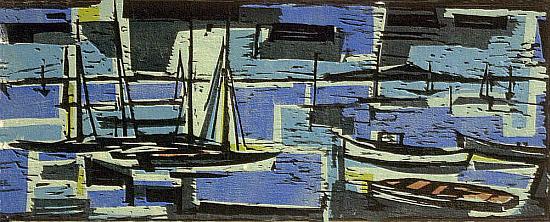
Calm Morning
Werner Drewes
1959
_______________________
The Symptom 11 » Spring 2010
In as much as The Symptom 11 addresses Lacan's theory from years ago, such as with Jacques-Alain Miller's "Symptom and Fantasm" from the 1983 Conferencias Porteñas, this same author's "The Non-Existent Seminar" from 1991, Slavoj Zizek's "Deleuze and the Lacanian Real" from early 2008, and Alain Badiou's "The Formulas of l'Étourdit" from Spring 2006, it may as yet alternate with their very actual input - Alain Badiou's "The Courage of the Present/Contemporary Obscurantism" published in Le Monde in February 2010, and Slavoj Zizek's "The Neighbor in Burka" from April 2010. Eric Laurent investigates the status of love in both its modern and contemporary sense, especially what this means for psychoanalysis, in "Of Disparity in Love," which was given at a conference at Tours in 1999. Pierre Gilles Guéguen in "On Women and the Phallus" from April 2010 deals with semblance as applied to the relation between man and woman. Mario Goldenberg's "Paranoid Park and the Secret" was inspired by Gus Van Sant's film that won the 60th Anniversary Prize at the 2007 Cannes Film Festival. François Régnault's "Psychoanalysis and Music," from March 2002, is very unique in that he explores the involvement of music as both an unconscious exercise and an exercise of the unconscious. The ladies walk forth with "A Very Natural Woman" by Marina Lusa and "Oscura Estampa" by Julia Goldenberg", both from 2010. Albert Herter's video clip emerges from his experience in analysis. Richard Kostelanetz seals up the issue with a 2010 political protest entitled, "Obama as Dubya in Disguise".
_______________________
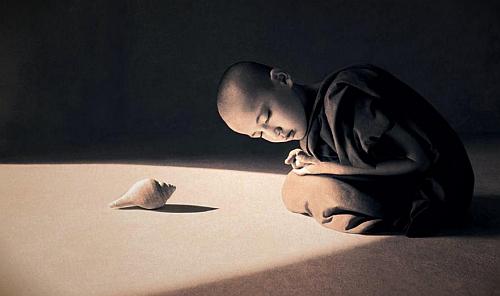
Gregory Colbert
_______________________
Throughout July Richard Hoffman has been posting some poems from Without Paradise at Mnemosyne's Memes
Lining-Off The Field
Richard Hoffman
(....)
Suppose the lines go on beyond the flags,
embracing houses, trees,
so many men and women, strangers
turning into friends or enemies, so many lovers,
towns, forests, lakes, rivers, stories
told and heard, forgotten or remembered,
understood or not. suppose the lines go on
because they do; imaginary, real.
...(more)
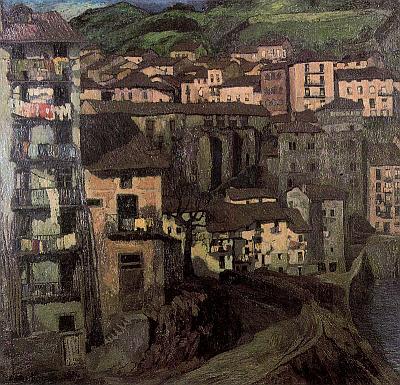
Ignacio Zuloaga
b. July 26, 1870
_______________________
Contextualizing Gerardo Diego's Handbook of Foams
Francisco Aragón
With ten poems from Handbook of Foams
translated from the Spanish by Francisco Aragón
jacket
Hotel
Gerardo Diego
(1896-1987)
translated by Francisco Aragón
for Alfonso Reyes
His head without a wreath or hat
and his heart’s the color in vogue
With every new dance
the clock loses a beat
showing the wrong hour
The wind blows from your cloak
caressing
the tango’s plucked fruit
Harvest of crushed clouds
and beloved modes of music
And the rhythm of sighs
makes the couples twirl
luring the lobby closer
Tightly shutting my eyes
I picture voyages
hotels anchoring the old keel
They’re islands like ocean liners
growing masts
abundant with winter fruit
where consumptives breathe
the tender oxygen
Upon hoisting the flag aromas
of wood are dispersed in the air
with the feathers of hunted birds
Autumn shrivels ties and hats
and from the carpet blooms spring
Roulette of chance and the seasons
Fashion’s jockeys raffle their colors
And whoever loses the bet
gets to waltz with a new lover
I love hotels and good weather
and I’ve seen women with roasted curls
The waves spraying them with cocktail foam _______________________

Eclipse of Sun
1926
George Grosz
b. July 26, 1893
_______________________
Dishonest clerks and the culture of capitalism
What's old is new again
Brian P. Luskey
common-place
It is banal to assert that capitalism benefits capitalists—elites have long been able to accumulate wealth in good times and weather economic storms in greater comfort than those who are less fortunate. Such banal assertions bear repeating, however, because elites obtain power through a culture of capitalism that shapes our assumptions about the legitimacy of economic conduct and our hopes and dreams for economic and social advancement. Nineteenth-century clerks—the copyists, bookkeepers, and salesmen whom I examine in On the Make—played various roles in the making of this culture. Some exhibited disdain for poor people who "scraped by" and insisted that their own economic pursuits were morally pure by comparison; dishonest embezzlers imperiled the economy, serving as contemptible figures who helped to justify capitalism; downtrodden clerks found themselves threatened by the economy and struggled to make ends meet. In On the Make, I show simultaneously that clerkships appeared to offer opportunities for upward mobility and that the young men who pursued them were clearly considered subordinate laborers. The debates about clerks and clerkships in nineteenth-century America are indeed relevant to our own times: as contests over the meanings of important keywords such as ambition, character, and class, they show the ways in which capitalism's opportunities and inequalities became the unquestioned organizing principles of American society and culture.
It is not enough for capitalists to have wealth; they feel that they must justify their access to and possession of capital. The pithy phrase "too big to fail" not only validates firms' impressive capital accumulation, but also privileges their economic survival over that of others without means. Many nineteenth-century clerks shared this condescending attitude toward the challenges ordinary folks faced during times of economic uncertainty....(more)
Common-Place
Vol. 10 · No. 04 · July 2010
_______________________
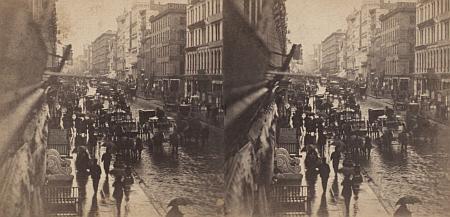
Broadway on a rainy day
Anthony's Instantaneous Views
ca. 1860
Anthony's Broadway on a Rainy Day
The stereograph comes to America
David Jaffee
common-place
_______________________
Course in General Linguistics
Jaswinder Bolina
agni
If I’m going to be attacked, let it be by a rare pathogen
not some yokel hurling
sand nigger at me
from a beat-up Cutlass Sierra at seven a.m.
If I’m going to be attacked,
let it be by asteroid or metastasis
not the toothless yahoo of my expectations.
What I can’t understand is
who has the energy to be a xenophobe at seven in the morning.
Not me anyway, though I have energy enough to think of language.
...(more)
_______________________
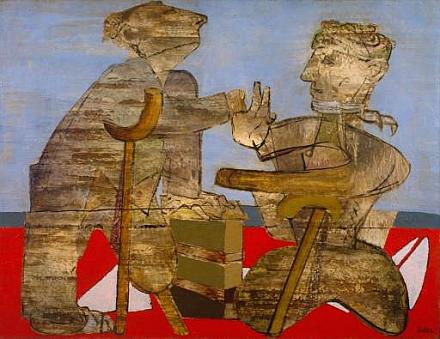
The Mutilated
1942-3
Jankel Adler
(July 26, 1895 – April 25, 1949)
_______________________
Schorr was musical, reflective; Cronkite, theatrical, sensational. Cronkite introduced the Beatles in 1963; Schorr delivered a eulogy on Frank Zappa in 1993.
Cronkite dispensed bulletins of News - the Official Version sanctioned by the ("that's the way it is") State. Schorr evoked events steeped in experiences - the burden of the storyteller.
Cronkite retired from CBS with dignified ceremonial auto-monumentality. Cronkite begat ingrate Rather, weepy witness of news as Melodrama. Schorr, fired by CBS for putting journalistic integrity above corporate interest, may have no worthy professional heirs.
- Tom Matrullo

John Wolf
_______________________
Ports
Paul Farley
(....)
IV
Ports rise and fall. The stars climb from the eastern sea.
The balance sheets all even out. The sand wipes clean.
Nobody comes here now except to dig deep down.
The nights are still and dark. There is no sound
Beyond the constant waves’ profit and loss sheets.
I was Carthage, tall and handsome as any city,
but the world has passed me by. The maps have been redrawn
and you can see how it might have been for Dido,
left standing while her life shipped out, moved on for home;
which sailors know lies off ahead and elsewhere.
The earth seems scorching to their feet. This will last forever,
Or as long as there are seas and men to sail them.
But I was Carthage, tall and handsome. Remember my name.
...(more)
Paul Farley at Poetry International Web
_______________________
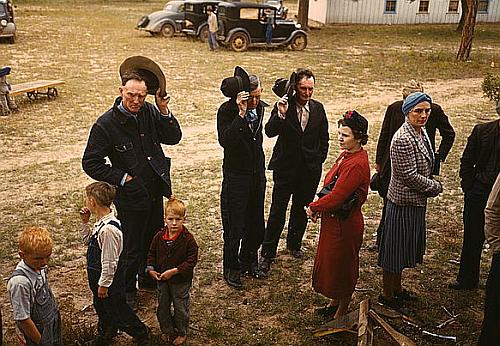
Saying grace before the barbecue
Pie Town, New Mexico Fair
Russell Lee
October 1940
At the Fair (I): Pie Town
Tom Clark
(....)
There are men whose words are as natural sounds without location, lost,
but the natural sounds of the women and their children
are the sounds of the places they have found.
So you found one another, or were found, with nothing left to speak of as your own you were welcomed and accepted, he says. There was something to eat and drink for everyone at the fair.
Those who have been here a while, though, lingering, seem to wear expressions of concern. Perhaps it's that they fear nothing has actually been promised us. We might not be able to stay on here after all.
Still they walk the roads in the evening, bare headed, hands now and then touching, saying little to one another, as the clouds gather, with the sun going down.
...(more)
At the Fair (II): Reality
At the Fair (III): Jockey Street/Juke Joint
_______________________
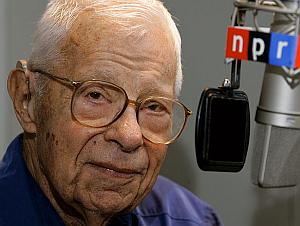
Daniel Schorr
August 31, 1916 – July 23, 2010
J. Scott Applewhite/Associated Press
2005Staying Tuned: A Life in Journalism
Daniel Schorr
google books
Daniel Schorr's Legacy: Speaking Truth To Power
David Folkenflik
‘We owe it to history to publish it.’
Daniel Schorr remembered
Kathy Olmsted
The Edge of the American West
I’m familiar with one small slice of this story: I did an intensive study of his coverage of the intelligence beat for CBS News from 1974 to 1976 – coverage that ultimately cost him his job. I came away from my research and from my interview with Schorr profoundly impressed by his commitment to disclosure and democracy. Schorr was true believer in the public’s right to know, and the historical record is richer for it.
To evaluate CBS’s coverage of the intelligence scandals, I watched every story that aired from 1974 to 1976 that mentioned the FBI or CIA. It added up to eight hours of stories, most of them by Schorr. Standing out amid the blandness of television journalism, Schorr was known for his literate pieces (he had begun his career as a print journalist) and for his rumpled appearance (a magazine profile described him as “gray, grouchy, and pouchy, looking like a refugee from an Alka-Seltzer ad”).
As I watched the clips, I became impressed by two points. First, Schorr’s stories were many times better than anything on the television news in the 1990s: he was smart, he made connections between events, he understood history, and he wasn’t afraid to challenge government claims of secrecy. Second, his stories were also much better than the ones by his colleagues at CBS in the 1970s. It wasn’t that a golden age in television news had come and gone: he was unique, even for the time....(more)
Challenging the secret government: the post-Watergate investigations of the CIA and FBIKathryn S. Olmsted google books
_______________________
A new study in the International Journal of Environmental Studies and Public Health conducted by British researchers has found a startling increase in the number of infant mortality and cancer cases in the Iraqi city of Fallujah since the 2004 U.S.-led bombardment of the area. The Independent reports that the cases “exceed those reported by survivors of the atomic bombs that were dropped on Hiroshima and Nagasaki”
- Think Progress
_______________________
Event of Oneself
52 ghazals
Nicola Masciandaro
mediafire pdf
(....)
Nameless desire, new epic longing for home,
Hurts my heart to think it, embers every bone.
Is there a way to sing, to speak so deep within,
Beneath it, out from under oceanic stone?
Where is the impasse, mountain, or immortal foe?
Where is the impossible it to face alone?
One foot there and one foot here, I walk all moments
Within it, across the chasm where I am thrown.
Light quilts the jagged, self-cutting city, healing,
Wholing it, sewing wounds for which we will atone.
So many portals, fractals. Each face a monster
And hero hunting it down a hole all its own.
Nicola girds himself in flesh and words and thoughts
About it, ready for what will be always known.
via aaaaarg
Nicola Masciandaro blogs at The Whim_______________________

John Wolf
via Notes
_______________________
Video Clips From Talon’s 2010 Cross-Canada Poetry Tour: Vancouver
video clips
Frank Davey
Stephen Collis
George Bowering
Ken Norris
derek beaulieu
Ken Belford
Weyman Chan
Garry Thomas Morse
_______________________
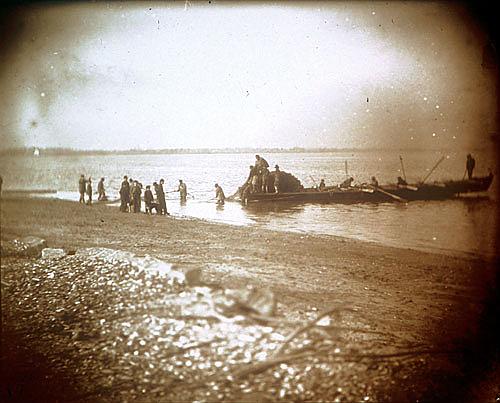
Setting the Net
Gloucester, New Jersey
1881
Thomas Eakins
b. July 25, 1844
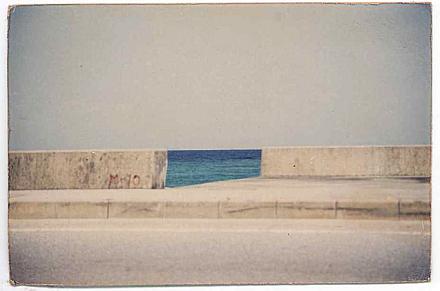
Masao Yamamoto
1 2 3 4
via Photographs Do Not Bend
_______________________
The Sound of Jazz
Yakov Lotovski
Translated from Russian by Dimitri Lotovski
exquisite corpse
The first time I heard the word jazz was from my uncle.
It was in the Soviet Union, in Kiev, soon after the war.
I was seven.
One night he just said it - this taboo word.
The chandelier with crystal pendants was hanging over his head.
The light from the lamp was breaking and refracting in their facets,
and the pendants were blazing up with different colors.
The chandelier was swinging a bit and slightly clinking.
I remember very clearly when he said jazz,
his gold tooth shined,
and the silver one in the depth of his mouth.
He pronounced it with a slight and sad smile
with which people speak about something unreachable,
and then suddenly he came to his senses
and looked cautiously at the door.
Back then there was this habit
to look cautiously at the door.
That's how the idea of jazz entered me
as something bright, exotic and forbidden.
...(more)
_______________________
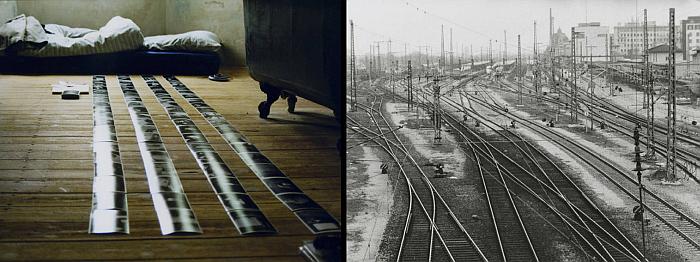
Tomorrow it will snow
text and photographs by Ieva Jansone
Camera Obscura
_______________________
'deaf'
M/C Journal
Vol. 13, No. 3 (2010)
Introduction: How Do We Learn What We Know?
Donna McDonald, Liz Ferrier
“Deaf.” How do we learn what we know about being deaf and about deafness? What’s the difference between “being deaf” and “deafness” as a particular kind of (non) hearing? Which would you rather be, deaf or blind: children commonly ask this question as they make their early forays into imagining the lives of people different from them. Hearing people cannot know what it is like to be deaf, just as deaf people cannot know what it is like to hear ... or can they? Finally, how can we tell fresh and authentic stories of “being deaf” and the state of “deafness” that disrupt our familiar—perhaps even caricatured—patterns of understanding?
In this special “deaf” edition of M/C Journal we wanted to create a body of work in which deaf writers and thinkers would have their say. Mindful that "Deaf history may be characterized as a struggle for Deaf individuals to 'speak' for themselves rather than to be spoken about in medical and educational discourses" (Bauman 47), we were particularly keen to place the contributions of deaf writers and thinkers alongside the mainstream hearing culture. This is why we have chosen not to identify each writer in this edition as deaf or hearing, preferring to leave that biographical auditory detail to the writers themselves....(more)
_______________________
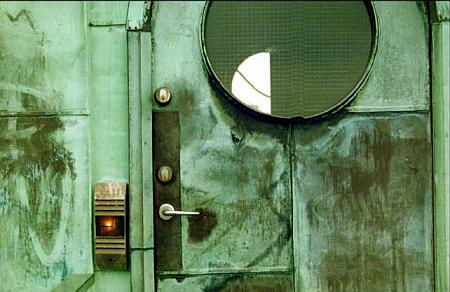
Ieva Jansone
_______________________
The Citizenry of Photography
John M. Woolsey reviews Ariella Azoulay. The Civil Contract of Photography.
Reviews in Cultural Theory
Editors: Imre Szemán, Sarah Blacker, Justin Sully
... a journal of book reviews that responds to new developments in the theorization of culture. Published online bi-weekly and collected into issues three times a year, Reviews in Cultural Theory seeks to provide a forum to foreground both new work in this field and the emergent community of scholars who share an interest in the complex and changing problematic of culture today.
Focusing on the wide distribution of short and timely reviews and review essays, the journal aims to remain responsive to the dynamism and pace of this field. The journal’s first three issues chart the contemporary shape of cultural theory as it touches on Visual Culture, Gender Studies, Geography, Queer Theory, Marxism, Anthropology, Critical Race Theory, Postcolonial Studies, Cultural History, and Sound Studies, among other fields and subjects, established and emerging. We welcome suggestions of new work for review.
_______________________
On Distraction
Our minds need to go on a diet.
Alain de Botton
One of the more embarrassing and self-indulgent challenges of our time is the task of relearning how to concentrate. The past decade has seen an unparalleled assault on our capacity to fix our minds steadily on anything. To sit still and think, without succumbing to an anxious reach for a machine, has become almost impossible.
The obsession with current events is relentless. We are made to feel that at any point, somewhere on the globe, something may occur to sweep away old certainties—something that, if we failed to learn about it instantaneously, could leave us wholly unable to comprehend ourselves or our fellows. We are continuously challenged to discover new works of culture—and, in the process, we don’t allow any one of them to assume a weight in our minds. We leave a movie theater vowing to reconsider our lives in the light of a film’s values. Yet by the following evening, our experience is well on the way to dissolution, like so much of what once impressed us: the ruins of Ephesus, the view from Mount Sinai, the feelings after finishing Tolstoy’s Death of Ivan Ilyich....(more)
via riley dog
_______________________
MyBrain.net
The colonization of real-time and other trends in Web 2.0
Geert Lovink
eurozine
The impact on the brain is an element picked up on by the Frankfurter Allgemeine Zeitung editor and Edge member Frank Schirrmacher in his book-length essay Payback (2009). Whereas Carr's take on the collapse of the white male's multi-tasking capacities had the couleur locale of a US IT-business expert a.k.a. East Coast intellectual, Schirrmacher moves the debate into the continental European context of an aging middle class driven by defensive anxiety over Islamic fundamentalism and Asian hypermodernity. Like Carr, Schirrmacher seeks evidence of a deteriorating human brain that can no longer keep up with iPhones, Twitter and Facebook on top of the already existing information flows from television, radio and the printed press. We are on permanent alert and have to submit to logic of constant availability and speed. Schirrmacher speaks of "I exhaustion". Most German bloggers responded negatively to Payback. Apart from factual mistakes, what concerned them most was Schirrmacher's implicit anti-digital cultural pessimism (something he denies) and the conflict of interest between his role as newspaper publisher and as critic of the zeitgeist. Whatever the cultural media agenda, Schirrmacher's call will be with us for quite some time. What place do we want to give digital devices and applications in our everyday life? Will the Internet overwhelm our senses and dictate our worldview? Or will we have the will and vision to master the tools?
The latest title in growing collection is virtual reality pioneer Jaron Lanier's You Are Not a Gadget (2010), which asks: "What happens when we stop shaping the technology and technology starts shaping us?" Much like Andrew Keen, Lanier's defence of the individual points at the dumbing down effect of the "wisdom of the crowd". In Wikipedia, unique voices are suppressed in favour of mob rule. This also crushes creativity: Lanier asks why the past two decades have not resulted in new music styles and subcultures, and blames the strong emphasis on retro in contemporary, remix-dominated music culture. Free culture not only decimates the income of performing artists, it also discourages musicians to experiment with new sounds. The democratization of digital tools has not led to the emergence of "super-Gershwins". Instead, Lanier sees "pattern exhaustion", a phenomena in which a culture runs out of variations on traditional designs and becomes less creative: "We are not passing through a momentary lull before a storm. We have instead entered a persistent somnolence and I have come to believe that we will only escape it when we kill the hive."
(....)
There is no evidence that the world is becoming more virtual. The cyber-prophets were wrong here. The virtual is becoming more real. It wants to penetrate and map out our real lives and social relationships. We are no longer encouraged to act out some role, but forced to be "ourselves" (which is no less theatrical or artificial). We constantly login, create profiles in order to present our "selves" on the global market place of employment, friendship and love. We can have multiple passions but only one certified ID. Trust is the oil of global capitalism and the security state, required by both sides in any transaction or exchange. In every rite de passage, the authorities must trust us before they let both our bodies and information through. The old idea that the virtual is there to liberate you from your old self has collapsed. It is all about self-management and techno-sculpturing: how do you shape the self in real-time flow? There is no time for design, no time for doubt. System response cannot deal with ambivalence. The self that is presented here is post-cosmetic. The ideal is to become neither the Other nor the better human. Mehrmensch, not Übermensch. The polished perfect personality lacks empathy and is straight-out suspect. It is only a matter of time until super persons such as celebrities reveal their weaknesses. Becoming better implies revealing who you are. Social media invite users to "administer" their all-too-human sides beyond merely hiding or exposing controversial aspects. Our profiles remain cold and unfinished if we do not expose at least some aspects of our private lives. Otherwise we are considered robots, anonymous members of a vanishing twentieth century mass culture. In Cold Intimacies, Eva Illouz puts it this way: "It is virtually impossible to distinguish the rationalization and commodification of selfhood from the capacity of the self to shape and help itself and to engage in deliberation and communication with others."...(more)
_______________________

Open Hand: Photo Essay
Shruti Singhi
Pyrta: A Journal of Poetry and Things
via NewPages
_______________________
World Music on Radio 3
Explore ten years of Radio 3 on-location recordings from 2000 to the present in our World Music archive, recording the life and musical traditions of countries ranging from Brazil to North Korea and Cuba to Turkmenistan.
via open culture
the best free cultural & educational media on the web
_______________________
George Oppen’s “Of Being Numerous”
Marjorie Perloff
sibila
... to what extent did the Oppen of “Of Being Numerous” actually reconcile himself to the social contract? And how did that “contract” relate to the “social totality” (membership in the Communist Party) of the 1930s, when Oppen renounced poetry for the sake of political work? These were questions posed in my Ironwood essay (#26, Fall 1985), and it seems worthwhile to raise them again today. What follows, then, is a heavily revised version of the earlier essay.
(....)7.
Obsessed, bewildered
By the shipwreck
Of the singular
We have chosen the meaning
Of Being Numerous.
In his correspondence, Oppen repeatedly refers to these lines as “the burden of the poem”—“the concepts evolved from the fact Of Being Numerous, without which we are marooned, shipwrecked.” And again:
I’m quite Marxist, indeed.
‘The shipwreck of the singular’ I wrote. We cannot live without the concept of humanity, the end of one’s own life is by no means equivalent to the end of the world, we would not bother to live out our lives if it were—-
And yet we cannot escape this: that we are single. And face, therefore, shipwreck.
“Humanity,” Nicholls notes, “is apparently rehabilitated here, but less as an existential reality than as a ‘concept’ or horizon which we need to live out our individual lives”. But what happens when “humanity” is reduced to a concept? Rescue, in this scheme of things, marks the return to a world where “we” are uncomfortably “pressed, pressed on each other.” And since that world is so distasteful to the poet—even a simple date like 1875 can intrude only intermittently on a “consciousness / Which loves itself”—any possibility of social transformation evaporates. “We have chosen,” says Oppen bravely, “the meaning / Of Being Numerous,” but it is not a “meaning” he can bring himself to accept....(more)
via the page
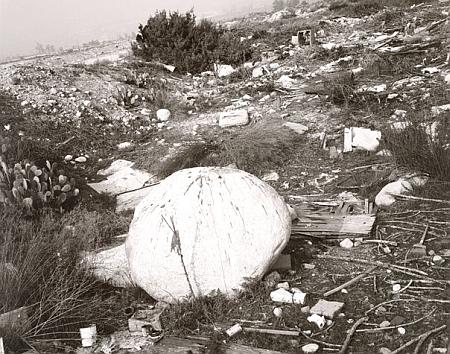
Santa Ana Wash
San Bernardino County, California
Robert Adams
1982
_______________________
postmedieval
a journal of medieval cultural studies
Volume 1, Issue 1-2 (Spring/Summer 2010)
Stories of stone
Jeffrey Jerome Cohena
postmedieval
Stone loves nothing more than story. Lapidaries are lithic narratives, the life histories of rocks, geocultural biographies. No medieval stone exists alone, but is an actor in a narrative that exceeds any use value, any practicality, a gem of aesthetic efflorescence that conveys conventional histories and received traditions beyond any border that they would ordinarily cross. Lapidaries were a major gateway for pagan learning back into orthodox Christianity. They carried into the present challenges, invitations and inducements to the imagination from medieval Europe's superseded past. Lapidary lore could thereby spur a reconceptualization of the present and the future in terms rather different from idées reçues – a reconfigured reality where rocks possessed an uncanny agency, where the world was far wider geographically and temporally than the small portion already mapped by its human inhabitants.
Lapidary knowledge: few objects are as heterodox, vagrant or powerful as stones....(more)
It's (for) you; or, the tele-t/r/opical post-human
Julian Yatesa postmedieval
The arrival, dissemination, and now normalization of the words ‘post-human’ or ‘post-humanism’ in literary, historical and cultural studies marks the addition of a new ‘actor’ or ‘actant’ to the assemblage of persons, machines, and the various parading of animal and plant remains employed to disseminate stories about the textual traces named ‘past.’ But what order of proposition or tropic operation is this ‘post-’ or ‘post-ing’ of the ‘human,’ this figural turning of the ‘human’ after or outside of itself? What is the nature of its call? What does the term activate?...(more)
_______________________

Colorado Springs, Colorado
1968
Robert Adams
1 2 3 4 5 6 7
One Life — Several Landscapes: An Appreciation of Robert Adams
Peter Brown
Perfect Uncertainty - Robert Adams and the American West
Leo Rubinfien
Back West: Reviewing American Landscape Photography
Stephen Longmire
The Missing Criticism - What We Bought
Tod Papageorge on Robert Adams
_______________________
Real Editors Ship
Paul Ford
...nearest to my heart there's an insane glut of historical data, texts, and so forth, billions of human, historical, textual objects to come online from the millennia before the web. Plus a gaggle of history bloggers trying to contextualize it (the history bloggers are the best bloggers out there—but that's for a different day). Dealing with the glut—and we must deal with this glut, because what is more important than sorting all human endeavor into folders?—will require all manner of editing, writing, commissioning, contextualizing, and searching. (Take a look at Lapham's Quarterly to see one very successful approach, using paper and ink.) Fortunes will be made! Not mine, of course, because I lack the qualities that money likes, but someone's. History is big business....(more)
.....................................................
... I think he’s getting at another twisty strand of this thing I’m thinking about as I keep coming back to the problem of how best for humans to make sense of data. There’s no way around it—computers are very good at finding patterns and humans are very good at finding meaning within those patterns. Computers are not so good at finding meaning in patterns. We keep trying to skip ahead, asking machines to find meaning for us, but the most momentous way to use the computation power available to us right now is to have human beings edit the patterns machines find in data, rather than to have human beings edit the data itself to make it more palatable to the machines in hopes that the machines will extract something important for us.
-
BlurryYellow _______________________

John Szarkowski
1925 - 2007
1 2
John Szarkowski profile
Sean O'Hagan
guardian
via Jim Johnson
Eyes Wide Open: Interview with John Szarkowski
Mark Durden
(2006)
John Szarkowski on William Eggleston _______________________
Newspaperism
Graham Wegner
Now we have the web. Initially, newspapers just reproduced themselves in an online form, still curating news that they felt their readers needed. But with RSS and social media, we can access news from any source and we now longer rely on one corporation to bring the news to us. But is that broadening our horizons or allowing us to insulate ourselves with our own self imposed limitations?
via Stephen's Web ~ OLDaily
_______________________
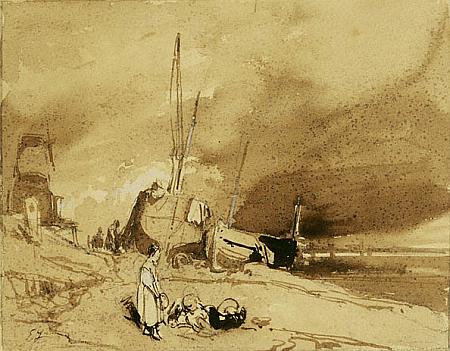
Eugène Isabey
b. July 22, 1803
_______________________
Lost Coast
Jennifer Elise Foerster
drunkenboat
1.
The continent dismantling.
I go to its shores, the outer
reaches of a fracturing hand.
I go to its shores to feed the black swans.
The violinist on the corner plucks
strings with his thumb.
The streets are a dress for your daughter—
I walk with her alongside the sun-blazoned beach,
her hand wrapped gently around my finger.
I plant lanterns in a dark garden.
Set bowls of milk out to draw the birds.
I listen to the radio for the names of the missing
then turn away from the mirror to call your lost name
as a white crescent moon turns the pages of light
and an old woman folds my dark photograph.
...(more)
_______________________
Lost Continent
Roberto Tejada
[after Rubén Ortiz-Torres]
(....)
... There were
two kinds
of breathing in the night; one that was jelly-colored
and semi-solid
the other stunted in rapture or awestruck in such unbreakable blaze
as with incense and coagulates, to the artery, to cells
that dividing
did duplicate, divide and duplicate again: cross-eyed,
very close
to the triangular nose, upper teeth in baskets and
bundles
like a shipment of newspapers very old admission stubs
a cheap
notebook — all things artless, half real anyway — if a casket
if a prankster effigy, reflected face in a thousand interlocking
parts of what followed from the center point where I
am
outside the fiberglass capital as in the one it beckons
from a middle
order meaning. ....
...(more)
A Tonalist Poetry Feature
jacket 40
_______________________
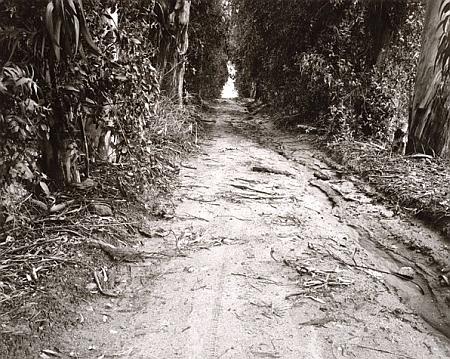
Eucalyptus Alley
Robert Adams
1983
_______________________
Blogging Is Dead; Long Live the Blog
Joshua Corey
Blogs used to be akin to both the front and back yard of one's literary house. In the front yard you'd make statements to the world at large about who you were and what you were about: there you'd display your topiary animals, your pink flamingos, flaunt the lack of a lawnmower, or what have you. The backyard - the emails and comments streams blogs generate - was where you'd host your barbecues and parties, though unfortunately increasing amounts of energy have had to be spent wrestling with or ejecting one's most unruly or obnoxious guests. Now Facebook is the backyard, for invitees only, and the parties are more civilized and sedate. But what's going on in the front yard? Who's sitting on the porch swing? Who's brewing up a pitcher of lemonade or sangria to offer to one's neighbors, or opening their literary house to those necessary strangers of literature, the readers?
As Gertrude Stein once said, "I write for myself and for strangers." And Facebook makes a poor substitute for the salon she and Alice B. Toklas curated together at 27 Rue de Fleurus. Blogs are for the self - and for strangers - in a way that Facebook can't be. Now, I don't blog as much as I used to, largely because of the demands of teaching and parenting. And no form of new social media has replaced, for me, the task of writing poetry and fiction - the old social media by which one communicates with the ultimate strangers, the great dead writers of the past whom one has loved, and readers unknown and unborn. But blogging has come to feel, in the new context created by Facebook and Twitter (both of which I take full advantage of), less ephemeral than it was - somehow closer to print, or at least to newsprint....(more)
_______________________

The Face of Minnesota
John Szarkowski
google booiks
_______________________
Six Poems
Angélica Tornero
translated by Krista Ingebretson
conjunctions
The zephyr rocked the dampened branches of a pimienta tree outside. It seemed to rain.
How did it not rear up foolish, my voice
in your eardrum,
when not even the hearth protruded from my lips,
words only rhythms or codes and not language not even what we believed?
Toothed into the crusts of the eyes we gave ourselves,
so as to not listen even to a stranger's language, because how
to listen to it when it has broken one’s own language and
conversation no longer sprouts from the house nor from history familial and domestic,
when words do not emerge from the mouth of the father and
from the grave of the others, nor from the oven
because it’s already off?
The codes were suspended there,
in a place discovered later,
when we found out about the rain.
My lips’ shiver in your pupil
was language that your flesh understood.
...(more)
 "It is quite clear that different parts of the wall are used to create different narratives in different contexts."
The border fortification as symbol of freedomJacob Kimvall Translation by Sonia Wichmann eurozine
During the twentieth anniversary celebration of the fall of the Berlin Wall, a symbolic wall consisting of dominoes was toppled. The dominoes were painted on both sides, something that could only have been done with a great deal of forgetting. In reality, there was graffiti only on the western side of the Wall, and that was put there illegally; but during the anniversary, unity seems to be more important than historical accuracy.
_______________________
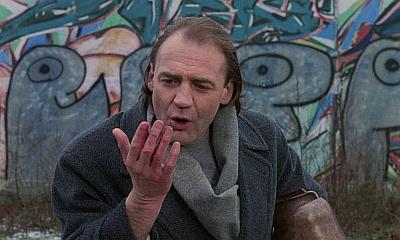 Bruno Ganz
Berlin Wall
Wings of Desire
_______________________
The Hunger of Sound
Robin Blaser
1925 - 2009
1
I asked a man to consider poetry.
I said
Begin then with this image:
A child's head bends in the light,
slips like a star across a man's mentality.
He and his guardian cat reach for a word.
Among stars, a man becomes a giant.
Take this image:
the masked face of a child,
insatiable of light.
A word found,
a child's voice—
this hunger of gulls
that fish from the broken edge of ice.
The child says, 'Draw me,'
and my hand trembles like a tree
first planted in chaos.
Hear the words sound a child's joy.
What is uprooted:
Hear the wind howl at a world of exact proportions.
A shape that was like him.
Hear the sound inhabit the mind,
bells in an orchard.
The words knock against chaos.
How measured a time that childhood,
joy and terror counted like marbles.
Beyond endurance, 10 fingers.
How measured the growth of the limbs upward.
Each word counted. The returning birds
or the new leaves counted.
On 10 fingers
the flowering peach of the orchard,
each blossom counted and named.
A child's voice
with the hunger of pigeons,
'10,000 '
...(more)
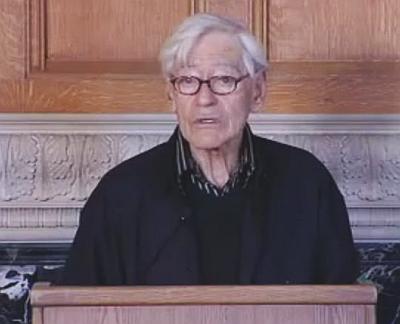
Lunch Poems - Robin Blaser
2008
youtube
via Pierre Joris
Robin Blaser
_______________________
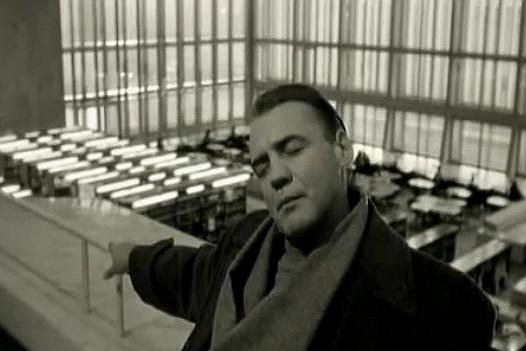 Bruno Ganz
library
Wings of Desire
_______________________
Modern scholarship is a race against its own obsolescence
Brian Lamb
abject learning
social learning, open education, and petty battles with rivals over power and money…
We took orientation classes in “research methods” to learn the basics. Because I worked part-time at the library while a student, I was something of a savant at gathering research — I could usually get most of what I needed for a short paper in only four or five hours! My ability to work the stacks was something that gave me an edge as a student, and I assumed this ability would serve me well as a scholar for many years.
Just before I finished my Masters, I was walking through the library and noticed tables loaded with shiny new computer terminals, and that one of them was set up with a CD-ROM version of the MLA International Bibliography. Out of curiosity I sat down and entered a few queries. I realized that my hard-earned foundational skills as a scholar could be easily surpassed by any newcomer with the ability to type a few words into a search box. What had once taken long hours of careful process could now be done in a few minutes, and with tools far more forgiving of error. I had spent years developing abilities that were rendered obsolete in an instant. As I recall, this realization left me with a sense of euphoria.
And of course the context of searching, identifying, gathering and reproducing information has only continued to evolve with dizzying speed. With so much changed about how research is now performed, what amazes me most is how little has changed with scholarship itself. Literary studies incorporate references exactly as they did back when I gathered them by hand. Articles are evaluated the same way. They are published in more or less the same places, in many cases more expensive for libraries to acquire than they were fifteen years ago. And if you do not belong to an authenticated university computer network, these works are effectively inaccessible to you....(more)
_______________________
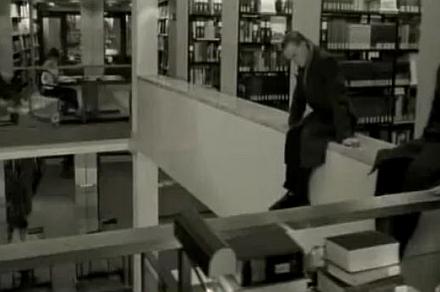
library
Wings of Desire
Wim Wenders
youtube
_______________________
...even while our hardcover sales continue to grow, the Kindle format has now overtaken the hardcover format. Amazon.com customers now purchase more Kindle books than hardcover books--astonishing, when you consider that we've been selling hardcover books for 15 years and Kindle books for 33 months.
- Jeff Bezos
_______________________
Industrial Ruins: Space, Aesthetics and Materiality
Tim Edensor
2005
ifile pdf - via aaaaarg
from the introduction
I have been drawn towards derelict and abandoned buildings since my childhood. This is partly because of the local geographies I have been familiar with but was also stimulated, I think, because the promise of extraordinary sights and mysterious experiences is built into the popular culture of children with its myriad tales of adventures in secret gardens, magical labyrinths and dense, enchanted forests. For me, however mundane they may seem, ruins still contain this promise of the unexpected. Since the original uses of ruined buildings has passed, there are limitless possibilities for encounters with the weird, with inscrutable legends inscribed on notice boards and signs, and with peculiar things and curious spaces which allow wide scope for imaginative interpretation, unencumbered by the assumptions which weigh heavily on highly encoded, regulated space. Bereft of these codings of the normative – the arrangements of things in place, the performance of regulated actions, the display of goods lined up as commodities or for show – ruined space is ripe with transgressive and transcendent possibilities. Ruins offer spaces in which the interpretation and practice of the city becomes liberated from the everyday constraints which determine what should be done and where, and which encode the city with meanings. Accordingly, they offer opportunities for challenging and deconstructing the imprint of power on the city. For as Henri Lefebvre declares, for a progressive urban politics to be effective, ‘the most important thing is to multiply the readings of the city’ (1996: 159).
_______________________
 Design by Anthony Gross
80 years of book covers at Faber & Faber
_______________________
As If By Chance
Robin Blaser
the Private Sector worries me
it can, the ubiquitous 'they' say, solve—that is, clear up—
the economy, which, at the upper level is called economics—that
is, confused science and confused theology prancing around
together as usual, is under the cultural, like oil or gas
under the hood or roof, and unpredictably disappearing from
under us
and the political, which, by manipulation, is over the stunned
polis, in order to manage production, distribution, and
consumption of wealth; becomes political economy—thus,
what is under becomes what is over, and vice versa, to define
realities without earth and sky which are cultural habitudes
and the cultural, which—not limited by high, low or middling—
is conflict around the creation of reality, and may be
invisible as thought is, and is neither formulaic—bonded
like chemicals—nor nostalgic, which is a dangerous and
transcendent condition, having forgotten that transcendence
like ourselves is historical, even in dreams
and the social, which is a struggle against dominations and powers
the society of which is recently made up of those who were not
previously there
and mass culture, which is new, misunderstood and ungenerous
about historical consciousness, mirrors privacies that dis
solve in soap, and is jubilant, from which sorrow may
learn
and democracy, which is recent, unAthenian, unPeriklean, in
complete, and by nature unstable and creative
and the sexual, which is the passionate body of all chemicals
...(more)
_______________________
Samuel Beckett: Debts and Legacies, 2010
A seminar sponsored by the University of Oxford and the University of Northampton
audio files from backdoor broadcasting
via Infinite Th0ught
_______________________
The Nothing That Is: Epistemologies of Creative Writing
Camelia Elias
Kritikos
an international and interdisciplinary journal of postmodern cultural sound, text and image
_______________________
Private Equity
Sophie Cabot Black
The New Yorker
To put one and one together making
Two and so on. A house appears, room
With a bed in it. To configure anyway,
Even without enough information.
We work into it, the chosen. To measure
Everything out until the one who takes over
Becomes taken. This as strategy, the art
Of how we build until management
In turn builds us, elegant the logic
Used. To draw out more than what is put in.
Everyone wants beyond; even with the one last page
As exit plan it is the return that is watched and how
We will be known. To end up where we start
Again, and to look as if we gained.
Sophie Cabot Black at the Poetry Foundation
_______________________
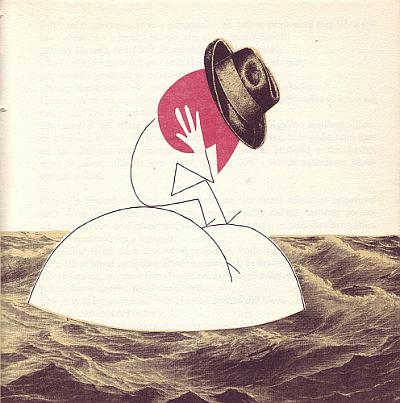
The Green Mare
Bohumil Stepan's illustrations for
Zelena Kobyla (The Green Mare) by Marcel Aymé,
Prague, 1966
A Journey Round My Skull
_______________________
The Anarchist Reader
George Woodcock (ed.)
mediafire pdf via aaaaarg

Mary Binney Montgomery
in Emlen Etting's
Oramunde
1933
_______________________
When hallucination encounters religion, the result is not always an attenuation of the hallucination to the level of socially acceptable fantasy. Yet even the paroxysm of hallucination can provide a temporary resolution. Less crushing a burden than the suffering due to burning desire or abandonment, hallucination can help the subject reestablish a kind of coherence, eccentric or aberrant though it may be. The resulting imaginary identity can sustain the individual and temporarily help him go on living.(....)
I want to stress the fact that the function of the psychoanalyst is to reawaken the Imagination and to permit illusions to exist. The function, or one of the functions? There is no question that analytic treatment of psychoses, more common now than in Freud's day, requires that the resurrection of the imagination be given first priority in the treatment; the therapeutic role of the imaginary graft (grette imaginaire) is thus magnified. If we look closely at the matter, however, it becomes clear that the structure of analytic language is essentially determined by a mnemonic technique, free association. Analytic discourse-in the first place that of the analysand, but also that of the analyst insofar as he listens to and attempts to deflect the discourse of the analysand through interpretation-issues from the web of imagination. It works with enticements, shams, approximations, "truths hic et nunc," to arrive at truths that become absolute only because they first find their exact meaning in the evanescence of the imaginary construct.
"The Unshakable illusion"
In the Beginning Was Love: Psychoanalysis and Faith
Julia Kristeva
pdf via aaaaarg
_______________________
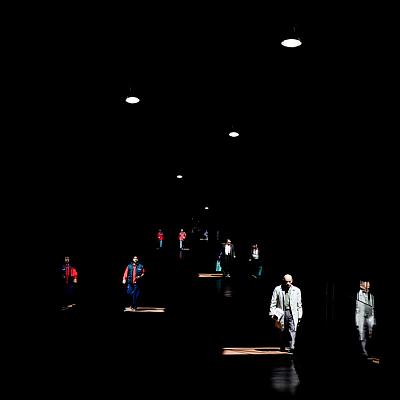
Traces of a Lonely Crowd
text and photographs by Manuel Vazquez
camera obscura
_______________________
Strange Spaces: Explorations into Mediated Obscurity
André Jansson and Amanda Lagerkvist (eds.)
Chapter 1 [pdf]
Reviewed by Peter Lugosi
Space and Culture
_______________________
The Bitter, True Taste of the Human Heart
Alex Cigale
Qarrtsiluni
After Samuel Beckett
I once knew a madman who thought the end
of the world had come. I would visit him
at the asylum, take him by the hand
and drag him to the window.
Corn rising,
and look there, the sails of the herring fleet.
What loveliness!
He’d snatch away his hand
and back into a corner, appalled. All
he saw was ashes, he alone was spared,
forgotten.
...(more)
Qarrtsiluni
_______________________
Waste Paper: a poem of profound insignificance
H.P. Lovecraft
1922
(....)
Have you a little T. S. Eliot in your home?
The stag at eve had drunk his fill
The thirsty hart look’d up the hill
And craned his neck just as a feeler
To advertise the Double-Dealer.
William Congreve was a gentleman
O art what sins are committed in thy name
For tawdry fame and fleeting flame
And everything, ain’t dat a shame?
Mah Creole Belle, ah lubs yo’ well;
Aroun’ mah heart you hab cast a spell
But I can’t learn to spell pseudocracy
Because there ain’t no such word.
And I says to Lizzie, if Joe was my feller
I’d teach him to go to dances with that
Rat, bat, cat, hat, flat, plat, fat
Fry the fat, fat the fry
You’ll be a drug-store by and by.
Get the hook!
Above the lines of brooding hills
Rose spires that reeked of nameless ills,
And ghastly shone upon the sight
In ev’ry flash of lurid light
To be continued.
No smoking.
Smoking on four rear seats.
Fare win return to 5¢ after August 1st
Except outside the Cleveland city limits.
In the ghoul-haunted woodland of Weir
Strangers pause to shed a tear;
Henry Fielding wrote Tom Jones.
And cursed be he that moves my bones.
Good night, good night, the stars are bright
I saw the Leonard-Tendler fight
Farewell, farewell, O go to hell.
Nobody home
In the shantih.
courtesy of Tom Raworth
_______________________
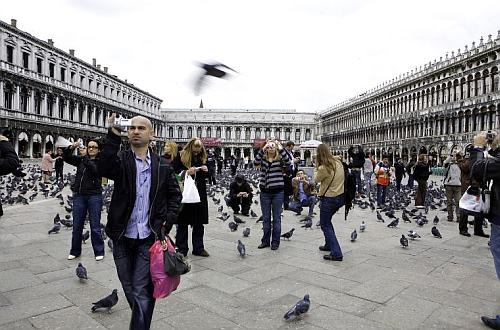
Save as
Manuel Vasquez
_______________________
What’s Really Going on Behind Murdoch’s Paywall?
Michael Wolff
My sources say that not only is nobody subscribing to the website, but subscribers to the paper itself—who have free access to the site—are not going beyond the registration page. It’s an empty world.
The wider implications of this emptiness are only just starting to become clear. A Murdoch and Fleet Street veteran with whom I’ve been corresponding about the paywall reported to me on his recent conversation with an A-list entertainment publicist: “What was really interesting to me was that this person volunteered a blinding realization. ‘Why would I get any of my clients to talk to the Times or the Sunday Times if they are behind a paywall? Who can see it? I can't even share a link and they aren't on search. It’s as though their writers don't exist anymore.’”...(more)
via Jerz's Literacy Weblog
_______________________

Easter Island
_______________________
Mute
Tom Clark
The broken statues stranded upon the shore
Thin-lip'd pouting ancestors who don't recognize their offspring
Any more. They've been knocked off their blocks
Toppled to the ground, buried, fractured in various places,
Replanted facing away from the sacred ground.
They speak inwardly to themselves of matters and concerns
That have been of no particular moment to anyone
At any time within memory.
Their words are bare murmurs
Scattered on the sea wind, lost
Fragments of unknown languages,
Whispers, half-audible subvocalisms,
Bits of sound as broken
As they are. The only audience is
A passing rack of cloud.
...(more)
_______________________
Digital Solipsism And The Paradox Of The Great ‘forgetting’
Neil Spiller
July/August 2010 issue of Architectural Design
courtesy of Lebbeus Woods

Johan and Ysbrant
1955
Johan van der Keuken
1938 - 2001
On photography as the art of anxiety
Alain Bergala
Introduction to The Lucid Eye
Nothing in Van der Keuken’s photographic work ever tries to absorb his permanent anxiety, to freeze his ceaseless meditation on the themes which preoccupy him, to offer any hope of one day attaining the serenity of even a temporary stability. The collection of these photos, taken by the same man between the ages of 15 and 60, finally separated from the stills from his films, provides for the first time striking evidence in book form of this permanent ontological anxiety, the spiral track of which is reflected in his successive photographic projects.(....)
Pessoa was able to put into words this feeling that the essence of things cannot be experienced in art, this condition of exile, of perceiving things through a window: ‘...when I say, “This is real”, even of a feeling, I see it despite myself in some exterior space, I perceive it with a sense which is somehow outside myself, foreign to myself’.’
Van der Keuken’s fascination with sleeping figures is related to this constant self-questioning about the reality of reality. This awful reality, of whose existence he has such difficulty convincing himself in his role as photographer, never exists so much, in his eyes, as when we are asleep, precisely because that is when we have parted company with our consciousness and are thus truly subject to the rule of unconsciousness: “Life”, he wrote, “is a dream or a voyage, or a dream of a voyage across a world which, of course, definitely exists outside us. We sleep because the world exists outside us (...)”. Consciousness, and in particular that of the photographer stalking his prey in a state of hyper-vigilance - just the opposite of the state of sleep, that is - is what distances us most surely from the reality of the world....(more)
_______________________
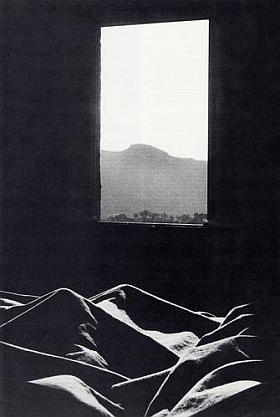
The mountains outside /
inside of the mountains
Johan van der Keuken
1975
_______________________
Lost in Thought
Nick Piombino
“This predilection for getting lost, this
was the sign beginning with which
all possibility opened.” - Jean Fremon
The arcades, so many doors.
Images calling to me from behind those doors.
The increasing impersonality of stores-
Starbucks’ tendency to offer an identical
experience everywhere.
As if there were a conscious attempt
to eliminate the necessity of thought.
Thought gradually becoming equal to
obedience.
The impossibility of thought, the
erosion of thought.
The retreat from thought.
Essential uncontrollability of thought.
Emotional turmoil associated with thought.
Looking for thoughts behind those doors,
faces, faces in thought.
Thoughts going on behind the faces.
Faces as doors that open and close.
Closure of thought, essential
immovability of thought.
Hurrying for thought,
hurriedness of thought,
thoughts interfering with
other thoughts,
paradox of thought,
contradictions of thought.
Thought’s eddying quality,
essential opacity
and permeability of thought.
Instability, transformability,
peculiarity, paradoxical
pettiness of thought,
thought’s dangers,
passivity of thought.
Levels of thought,
simultaneities,
coincidences, thought
within thought, intellectual
bias of thought, thought’s
cul-de-sacs, detours,
stereotypes, one-way-streets,
reproducibility,
identifiability,
transferability,
capability of condensation,
thought’s tendency to
unearth and sustain origins.
(....)
in

50/50: Words & Images for Didi Menendez
edited by Grace Cavalieri and April Carter Grant
This anthology contains poems, essays, and visual works from writers and poets who have been published by Didi Menendez in MiPOesias magazine, OCHO, Poets and Artists (O&S), or books. Each piece is about or dedicated to Didi in celebration of her long-standing commitment to advancing print and web standards for independent publishing of poetry and art. Full-color interior.
Contributors: Barbra Nightingale, Diego Quiros, Suzanne Frischkorn, Ivy Alvarez, Ron Androla, Nick Piombino, Holly Picano, Michael Parker, Meghan Punschke, Amy King, John Korn, Grady Harp, Jose Parra, David Lehman, Matthew Hittinger, Cheryl Townsend, Andrew Demcak, Bruce Covey, Luc Simonic, Diana Adams, Charles Jensen, Reb Livingston, Karen Hollingsworth, Melissa McEwen, Wiliam Stobb, Nick Carbo, Pris Campbell, Denise Duhamel, Edward Nudelman, Marie-Elizabeth Mali, Geoffrey Gatza, Emma Trelles, Miguel Murphy, Jeremy Baum, Kirk Curnutt, Michelle M. Buchanan, Evie Shockley, Dan Murano, LD Grant, April Carter Grant, Tony Trigilio
pdf available herevia fait accompli
_______________________
An interview with Andrew Nikiforuk
writer in residence at The Tyee
I want to start more conversations about energy in general, as well as fossil fuels and how they've changed our thinking and our culture. I want to look at the whole concept of energy slaves. Slavery ended just as the age of petroleum began. One barrel of oil does the same amount of work as one human slave working for eight years for a family. When people become dependent on slaves or for that matter energy slaves in the form of petroleum, all social relations change. During the nineteenth century slave societies were known for their moral carelessness, brutality and indolence. In a strange sort of way, cheap oil has given us the same sort of frailties and vulnerabilities once associated with slave owners. Nineteenth-century slave holders didn't have much insight about the moral consequences of their dependency on slave labour. Nor do we....(more)
_______________________
Tottenville Review
Issue #1, Spring 2010
a new review of books focused on debuts, translations, and all works that would otherwise go undetected. It is a collaborative of authors, translators, and reviewers bound by one purpose: to contribute to the dialogue of literature.
via NewPages
_______________________

Metro, Paris, 1957
Johan Van Der Keuken
|


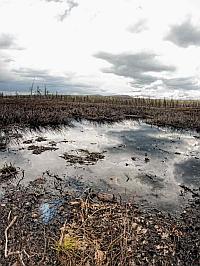
 Janus Head
Janus Head

 The Age of Briggs & Stratton
The Age of Briggs & Stratton
















































